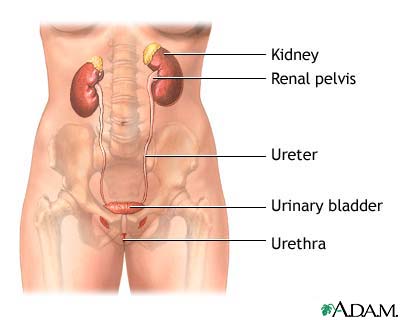Symptoms & Signs
- Frequent urination, in the daytime and at night
- Involuntary loss of urine
- Sudden and urgent need to urinate (urinary urgency)
Diagnosis & Tests
During a physical examination, the health care provider will look at the abdomen and rectum. Women will also have a pelvic exam. Men will also have a genital exam. In most cases the physical exam reveals nothing abnormal.
If there are nervous system (neurologic) causes, other abnormalities may be found.
Tests include the following:
- EMG (myogram) – rarely needed
- Inspection of the inside of the bladder (cystoscopy)
- Pad test (after placement of a previously weighed sanitary pad, the patient exercises, then the pad is weighed to determine urine loss)
- Pelvic or abdominal ultrasound
- Post-void residual volume (PVR) to measure amount of urine left after urination
- Urinalysis or urine culture to rule out urinary tract infection
- Urinary stress test (the patient stands with a full bladder and coughs)
- Urodynamic studies (measurement of pressure and urine flow)
- X-rays with contrast dye
Further tests will be performed to rule out other types of incontinence. The “Q-tip test” measures the change in the angle of the urethra at rest and when straining. An angle change of greater than 30 degrees often is a sign that the muscles supporting the bladder are weak. This is common in stress incontinence.
Pictures & Images
Female urinary tract
-
Urge incontinence: Overview, Causes
-
Urge incontinence: Symptoms & Signs, Diagnosis & Tests
-
Urge incontinence: Treatment
Review Date : 3/5/2010
Reviewed By : A.D.A.M. Editorial Team: David Zieve, MD, MHA, David R. Eltz. Previously reviewed by Louis S. Liou, MD, PhD, Assistant Professor of Urology, Department of Surgery, Boston University School of Medicine (8/30/2009).
![]()
